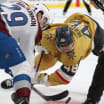At this point in the season, here's the big thing I've noticed.
It's been said for a while now that where you are in
the playoff race
at Thanksgiving is where you are going to end up at the end of the seasons. But there are so many teams that are so close, it's really starting to look like that might not be the case this season.
RELATED: [All Coaches Room stories]
If so, that would be a huge change from the norm.
The reason I say that: There are a number of teams near the bottom that I didn't expect to be there. Maybe that's a sign this will be one of these rare go-against-the-flow seasons when everything is so wide open, there still could be a lot of movement in the standings by the time all is said and done.
That's something I've been looking at lately. When you examine the pecking order in the NHL right now, it looks like a free-for-all. In a lot of cases, you're not sure which teams will be around for the playoffs come April. That's how wide open it is.
Usually by this time of the season, you have four or five teams that are lagging behind in the standings and already seem to be long shots to qualify for the postseason. Right now, though, other than maybe the Arizona Coyotes and Buffalo Sabres, everyone seems to be in the mix.
History has shown that more often than not, the standings at Thanksgiving are a harbinger of what's to come. Normally they're pretty accurate as to how things will play out.
RELATED: [Up-to-date NHL standings]
But it's different this season because the parity in the League is front and center on display.
Admittedly, the salary cap has evened out the playing surface since the NHL implemented it in 2005. In the 12 years since then, front offices have gotten a better grasp on how to use the cap in the most efficient, productive manner.
At the same time, I consider there to be another very big factor in all of this: the increase in the number of quality young players being developed.
Think about the League and its series of expansions -- six teams to 12 teams to 16 teams to 21 teams. Back in the 1980s when there were 21 teams, there were so many good players. In the next two or three decades, the League grew by another 10 teams. And while that was going on, player development changed significantly as well. Players started working out 12 months a year, and at younger ages. It's gotten to the point today that some kids are NHL-ready in their teens.
As a result, there are so many quality players around, all 31 teams have so many of them. And it's hard to hide them. A team like the Vegas Golden Knights, maybe they don't have a No. 1 center or No. 1 defenseman, but they're not a team of No. 6 or No. 7 defensemen either. When you look at a team's 20-man roster, the Knights have a lineup full of No. 7 to No. 10 guys on that roster. That's why they're so competitive. They have so many solid players; every night is a fine line between winning and losing.


















